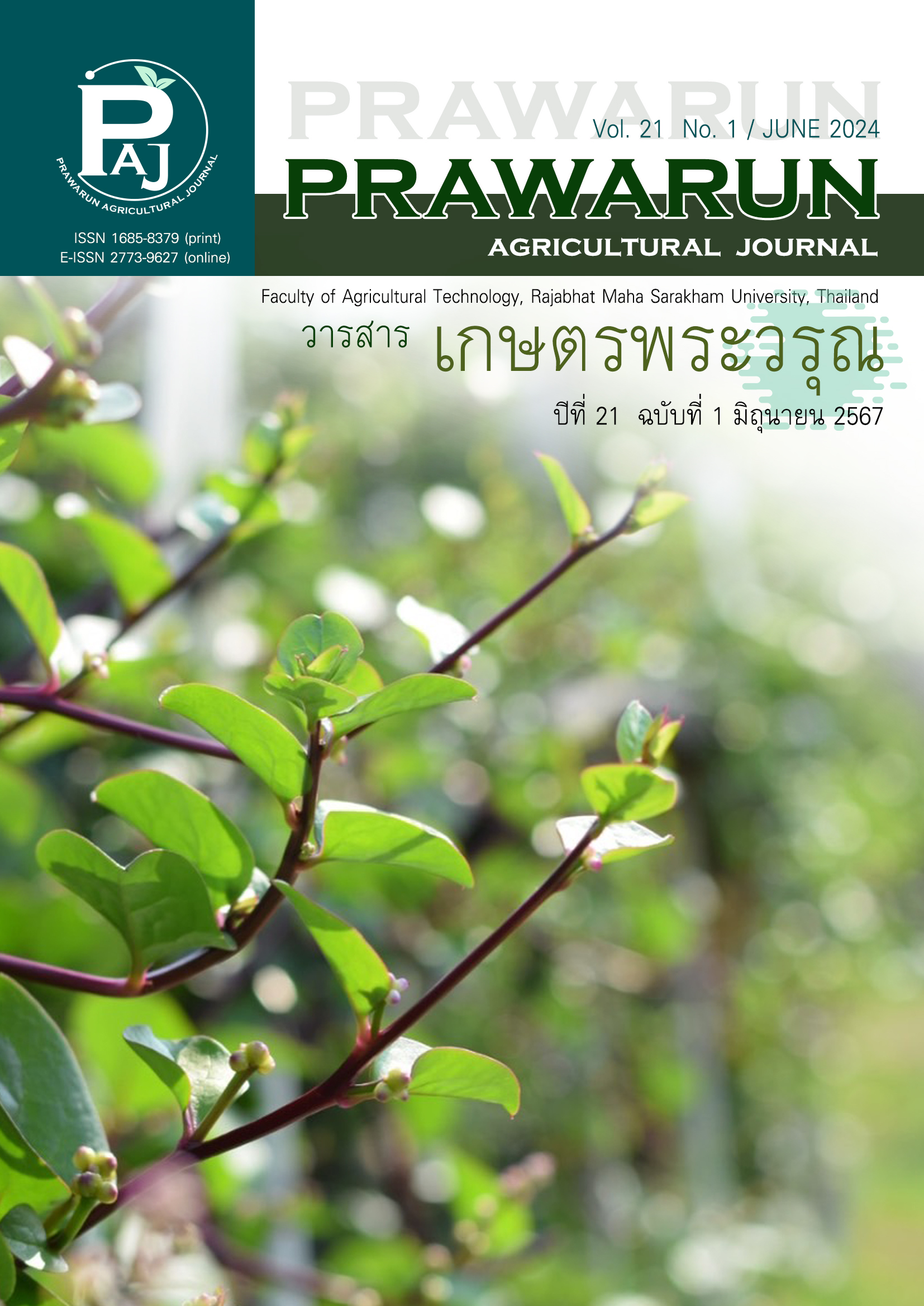การเสริมผงกานพลูร่วมกับการบรรจุแบบสุญญากาศต่อคุณภาพและอายุการเก็บรักษาผลิตภัณฑ์ไส้กรอกไก่
Main Article Content
บทคัดย่อ
ผงกานพลูเป็นเครื่องเทศที่ใช้กันอย่างแพร่หลายในอุตสาหกรรมการผลิตอาหาร เนื่องจากอุดมไปด้วยสารยูจีนอลที่สามารถยับยั้งการเจริญเติบโตของแบคทีเรียและเชื้อรา ลดการเกิดสารอนุมูลอิสระ จึงถูกนำมาใช้เพื่อปรุงแต่งรสและยืดอายุการเก็บรักษาอาหารให้ยาวนานขึ้น งานวิจัยนี้มีวัตถุประสงค์เพื่อศึกษาผลของการเสริมผงกานพลูร่วมกับการบรรจุแบบสุญญากาศต่อคุณภาพการเก็บรักษาไส้กรอกไก่ โดยมีปัจจัยการทดลอง คือ ระดับการเสริมผงกานพลู 3 ระดับ ได้แก่ 0 3.5 และ 5 กรัมต่อกิโลกรัม หลังจากนั้นทำการเก็บไส้กรอกไก่ไว้ที่อุณหภูมิ 4 °C เป็นเวลา 5 7 และ 14 วัน ระหว่างนั้นทำการวัดค่าการสูญเสียน้ำระหว่างการเก็บรักษา ณ ชั่วโมงที่ 24 และ 48 และวันที่ 5 7 และ 14 ทำการวัดค่าการสูญเสียน้ำอันเนื่องมาจากการปรุงสุก ค่าสี และการปนเปื้อนของแบคทีเรียทั้งหมด ผลการทดลอง พบว่า ผงกานพลูสามารถลดค่าการสูญเสียน้ำระหว่างการเก็บรักษาและค่าการสูญเสียน้ำระหว่างการปรุงสุกลงได้อย่างมีนัยสำคัญทางสถิติ (P < 0.05) ด้านค่าสี พบว่า การเสริมผงกานพลูไม่ส่งผลต่อค่าสีแดงและค่าสีเหลืองของไส้กรอกไก่ ด้านการปนเปื้อนของเชื้อแบคทีเรียทั้งหมด พบว่า ณ วันที่ 7 และ 14 ของการเก็บรักษา กลุ่มที่มีการเสริมผงกานพลูที่ระดับ 5 กรัม มีปริมาณแบคทีเรียปนเปื้อนน้อยที่สุด และต่ำกว่ากลุ่มควบคุมอย่างมีนัยสำคัญทางสถิติ (P < 0.05) จากผลการทดลองจะเห็นได้ว่า การเสริมผงกานพลูสามารถยืดอายุการเก็บรักษาผลิตภัณฑ์ไส้กรอกไก่ที่ผ่านการบรรจุแบบสุญญากาศได้
Article Details
เอกสารอ้างอิง
Aaslyng, M. D., Bejerholm, C., Ertbjerg, P., Bertlam, M. C., & Henrik, J. A. (2003). Cooking loss and juiciness of pork in relation to raw meat quality and cooking procedure. Food Quality and Preference, 14(4), 277-288.
doi.: 10.1016.S0950.3293(02)00086-1
American Meat Science Association. (2012). Meat color measurement guidelines. Accessed August 15, 2021. Retrieved from https://meatscience.org/docs/default-source/publications-resources/hot-topics/2012_12_meat_clr_guide.pdf
Bacteriological Analytical Manual. (2001). Aerobic plate count. Accessed November 28, 2022. Retrieved from https://www.fda.gov/food/laboratory-methods-food/bam-chapter-3-aerobic-plate-count
Burt, S. (2004). Essential oils: their antibacterial properties and potential applications in foods --a review. International Journal of Food Microbiology, 94(3), 223-253.
doi: 10.1016/j.ijfoodmicro.2004.03.022
Chen, H., Diao, J., Li, Y., Chen, Q., & Kong, B. (2016). The effectiveness of clove extracts in the inhibition of hydroxyl radical oxidation-induced structural and rheological changes in porcine myofibrillar protein. Meat Science, 111, 60–66.
doi: 10.1016/j.meatsci.2015.08.017
De Azeredo, G. A., Stamford, T. L. M., Nunes, P. C., Neto, N. J. G., de Oliveira, M. E. G., & de Souza, E. L. (2011). Combined application of essential oils from Origanum vulgare L. and Rosmarinus officinalis L. to inhibit bacteria and autochthonous microflora associated with minimally processed vegetables. Food Research International, 44(5), 1541–1548.
doi.: 10.1016/j.foodres.2011.04.012
El-Maati, M. F. A., Labib, S. M., Al-Gaby, A. M. A., & Ramadan, M. F. (2016). Antioxidant and antibacterial properties of different extracts of garden cress (Lepidium sativum L.). Zagazig Journal of Agricultural Research, 43(5), 1685-1697.
doi: 10.21608/zjar.2016.98127
Ertas, O. N., Guler, T., Ciftci, M., Dalkilic, B., & Simsek, U. G. (2005). The effect of an essential oil mix derived from oregano, clove and anise on broiler performance. International Journal of Poultry Science, 4(11), 879-884. doi: 10.3923/ijps.2005.879.884
Fauzya, A. F., Astuti, R. I., & Mubarik, N. R. (2019). Effect of ethanol-derived clove leaf extract on the oxidative stress response in yeast Schizosaccharomyces pombe. International Journal of Microbiology, 2019(1), 2145378.
doi: 10.1155/2019/2145378
Govari, M., & Pexara, A. (2018). Nitrates and nitrites in meat products. Journal of the Hellenic Veterinary Medical Society, 66(3), 127–140. doi: 10.12681/jhvms.15856
Gulçin, I., Kufrevioglu, O. I., Oktay, M., & Büyükokuroglu, M. E. (2004). Antioxidant, antimicrobial, antiulcer and analgesic activities of nettle (Urtica dioica L.). Journal of Ethnopharmacology, 90(2-3), 205-215.
doi: 10.1016/j.jep.2003.09.028
Hustad, G. O., Cerveny, J. G., Trenk, H., Deibel, R. H., Kautter, D. A., Fazio, T., Johnston, R .W., & Kolari, O. E. (1973). Effect of sodium nitrite and sodium nitrate on botulinal toxin production and nitrosamine formation in wieners. Applied Microbiology, 26(1), 22-26.
doi: 10.1128/am.26.1.22-26.1973
Jin, S. K., Choi, J. S., Jeong, J. Y., & Kim, G. D. (2016). The effect of clove bud powder at a spice level on antioxidant and quality properties of emulsified pork sausage during the cold storage. Journal of the Science of Food and Agriculture, 96(12), 4089-4097.
doi: 10.1002/jsfa.7609
Khaleque, M. A., Keya, C. A., Hasan, K. N., Hoque, M. M., Inatsu, Y., & Bari, M. L. (2016). Use of cloves and
cinnamon essential oil to inactivate Listeria monocytogenes in ground beef at freezing and
refrigeration temperatures. Food Science and Technology, 74(4), 219-223.
doi: 10.1016.j.lwt.2016.07.042
Kong, B., Zhang, H., & Xiong, Y. L. (2010). Antioxidant activity of spice extracts in a liposome system and in cooked pork patties and the possible mode of action. Meat Science, 85(4), 772–778.
doi: 10.1016/j.meatsci.2010.04.003
Kumar, D., & Tanwar, V. K. (2011). Utilization of clove powder as phyto-preservative for chicken nuggets preparation. Journal of Stored Products and Postharvest Research, 2(1), 11 – 14.
doi: 10.5897/JSPPR.9000049
Lone, Z. A. (2022). Phytochemical analysis of clove (Syzygium aromaticum) dried flower buds extract and its therapeutic importance. Journal of Drug Delivery and Therapeutics, 12(4-s), 87-92.
doi: 10.22270/jddt.v12i4-s.5628
Moon, S. E., Kim, H. Y., & Cha, J. D. (2011). Synergistic effect between clove oil and its major compounds and antibiotics against oral bacteria. Archives of Oral Biology, 56(9), 907-916.
doi: 10.1016.j.archoralbio.2011.02.005
Ragni, L., Berardinelli, A., Vannini, L., Montanari, C., Sirri, F., Guerzoni, M. E., & Guarnieri, A. (2010). Non-thermal atmospheric gas plasma device for surface decontamination of shell eggs. Journal of Food Engineering, 100(1), 125-132. doi: 10.1016.j.jfoodeng.2010.03.036
Sen, N. P., Smith, D. C., & Schwinghamer, L. (1969). Formation of N-nitrosamines from secondary amines and nitrite in human and animal gastric juice. Food and Cosmetics Toxicology, 7(4), 301-307.
doi: 10.1016/S0015-6264(69)80366-4
Statistical Analysis System (SAS). (1998). SAS/STAT user’ guide. North Carolina, United States: SAS Institute Inc.
Steel, R. G. D., & Torrie, J. H. (1980). Principles and procedures of statistics: a biometrical approach (2nd ed.). New York, United States: Mc Graw-Hill Book Co.
Suliman, G. M., Alowaimer, A. N., AI-Mufarrej, S. I., Hussein, E. O. S., Fazea, E. H., Naiel, M. A. E., Alhotan, R. A., & Swelum, A. A. (2021). The effects of clove seed (Syzygium aromaticum) dietary administration on carcass characteristics, meat quality, and sensory attributes of broiler chickens. Poultry Science, 100(3), 100904.
doi: 10.1016/j.psj.2020.12.009
Warner, R. D. (2017). Chapter 14 -The eating quality of meat- IV water-holding capacity and juiciness. In T. Fidel Ed.), Lawrie’s Meat Science (pp. 419-459). Cambridge, England: Woodhead Publishing series in Food Science, Technology and Nutrition.
doi: 10.1016/B978-0-08-100694-8.00014-5


